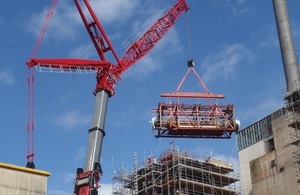A four-year project to dismantle 3,000 tonnes of steelwork at Scotland's first nuclear reactor has been safely completed.

The multi-million pound decommissioning project has drawn to a close with the removal of the top section of each of the sixteen, 100-foot tall, heat exchangers at the Nuclear Decommissioning Authority's (NDA) Chapelcross Site near Annan.
It takes the site another step towards closure and has further changed the local skyline. Take a look at this video for an overview of the work involved.
This last phase of the project involved working with the Low Level Waste Repository (LLWR) who transported over 400 tonnes of metal by ship to a smelting plant in Sweden, where it is anticipated that 95% will be cleaned and recycled. A further 400 tonnes has already been released through standard recycling routes.
John Grierson, Chapelcross Site Closure Director, said: "The heat exchanger decommissioning project has been a real team effort and I would like to thank everyone involved at Magnox, the main contractor Hertel and their sub-contractors Mammoet, Mott McDonald, J&S Plant, Cyclife and their subcontractors for moving the components and our colleagues at LLWR. Together we have delivered a significant hazard reduction project safely."
More than 2,000 tonnes of clean metal from the project has already been sent for recycling and the scaffolding that has now been taken down is being transferred across the NDA estate for re-use.
As part of the project a 1,200 tonne crane, that took three days to construct, was used for the heaviest metal movements – the largest crane to be on site since construction in the late 1950s.
John added: "In March 2015, following many months of preparatory activities, the first two 95-tonne cranes arrived at site. The project has used 95, 500, 750 and 1200-tonne cranes, sometimes with five cranes in operation at one time. It has been an intensity of work we will not experience again at Chapelcross until final demolition activities."
Dave Rossiter, Head of Waste Management Services at LLWR, said: "The project was a challenge for our team because of the size of the components and the logistical planning we had to incorporate, as well as the unexpected roadworks, but they performed well.
"We've built on the experience gained in previous projects such as the movement of the Berkeley Site boilers and other complex logistical projects."






